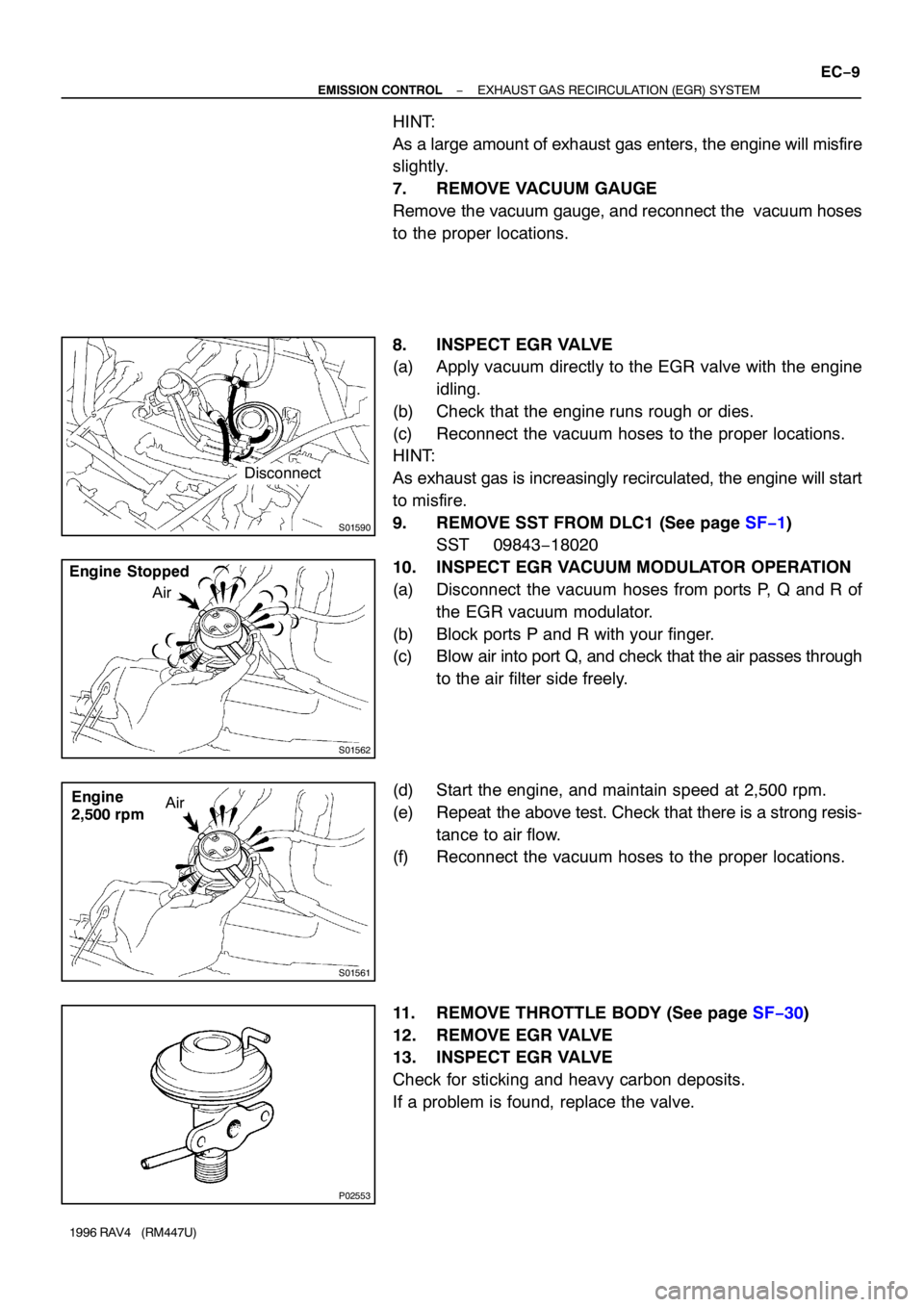Page 329 of 1354
P00495
Outside
Inside
− DIAGNOSTICSENGINE
DI−9
1996 RAV4 (RM447U)
4 Check air filter.
PREPARATION:
Remove air filter.
CHECK:
Visually check that the air cleaner element is not excessively
dirty or oily.
HINT:
If necessary, clean element with compressed air.
First blow from inside thoroughly,then blow from outside of ele-
ment.
NG Repair or replace.
OK
5 Check idle speed.
PREPARATION:
(a) Warm up engine to normal operating temperature.
(b) Switch off all accessories.
(c) Switch off air conditioning.
(d) Shift transmission into ”N” position.
(e) Connect the OBDII scan tool or TOYOTA hand−held tes-
ter to DLC3 on the vehicle.
CHECK:
Use CURRENT DATA to check the engine idle speed.
OK:
Idling speed: 650 − 750 rpm
NG Proceed to matrix chart of problem symptoms
on page DI−20.
OK
Page 369 of 1354
− DIAGNOSTICSENGINE
DI−49
1996 RAV4 (RM447U)
2 Check for oxygen sensor data.
PREPARATION:
(a) Connect the OBDII scan tool or TOYOTA hand−held tester to the DLC3.
(b) Warm up engine to normal operating temperature.
CHECK:
Read the oxygen sensor output voltage and short−term fuel trim.
RESULT:
PatternOxygen sensor output voltageShort−term fuel trim
1Lean condition (Changes at 0.55 V or less)Changes at about +20 %
2Rich condition (Changes at 0.35 V or more)Changes at about −20 %
3Except 1 and 2
3 Check for oxygen sensor
(See page DI−42).
1, 2
3 Check fuel pressure (See page SF−5).
NG Check and repair fuel pump, pressure regulator,
fuel pipe line and filter (See page SF−1).
OK
4 Check injector injection (See page SF−21).
NG Replace injector.
OK
5 Check manifold absolute pressure sensor and engine coolant temp. sensor
(See page DI−21, DI−29).
NG Repair or replace.
OK
Page 374 of 1354
DI−54
− DIAGNOSTICSENGINE
1996 RAV4 (RM447U)
3 Check injector resistance of misfiring cylinder (See page SF−21).
NG Replace injector.
OK
Check for open and short in harness and con-
nector between injector and ECM (See page
IN−30).
4 Check fuel pressure (See page SF−5).
NG Check and repair fuel pomp, pressure regulator,
fuel pipe line and filter (See page SF−1).
OK
5 Check injector injection (See page SF−21).
NG Replace injector.
OK
6 Check EGR system (See page SF−45).
NG Repair EGR system.
OK
7 Check manifold absolute pressure sensor and engine coolant temp. sensor (See
page DI−21, DI−29).
Page 387 of 1354
A00407
System: (OFF) System: (ON)Air
GGAir
EE
Air Filter
− DIAGNOSTICSENGINE
DI−67
1996 RAV4 (RM447U)
TOYOTA hand−held tester
1 Check the connection of the vacuum hose, EGR hose (See page EC−5).
NG Repair or replace.
OK
2 Check the VSV for EGR.
PREPARATION:
Select the ACTIVE TEST mode on the TOYOTA hand−held tes-
ter.
CHECK:
Check operation of VSV, when it is operated by the TOYOTA
hand−held tester.
OK:
EGR system is OFF:
Air from pipe E is flowing out through the air filter.
EGR system is ON:
Air from pipe E is flowing out pipe G.
OK Go to step 4.
NG
3 Check operation of the VSV for EGR (See page SF−43).
NG Replace VSV for EGR.
OK
Check for open and short in harness and con-
nector between R/B No.6 and ECM
(See page IN−30).
Page 389 of 1354
A00408
ON
EGR
(+)ONOFFE4 connector
Air
(ON) (OFF) G
Air FilterE
GEAir
− DIAGNOSTICSENGINE
DI−69
1996 RAV4 (RM447U)
2 Check the VSV for EGR.
PREPARATION:
(a) Remove side trim cover (See page SF−62).
(b) Disconnect the E4 connector of ECM.
(c) Turn ignition switch ON.
CHECK:
Check VSV function.
(1) Connect between terminal EGR of ECM connector
and body ground. (ON)
(2) Disconnect between terminal EGR of ECM connec-
tor and body ground. (OFF)
OK:
(1) VSV is ON:
Air from pipe E is Flowing out through the air filter.
(2) VSV is OFF:
Air from pipe E is flowing out pipe G.
OK Go to step 4.
NG
3 Check operation of the VSV for EGR (See page SF−43).
NG Replace VSV for EGR.
OK
Check for open and short in harness and con-
nector between R/B No.6 and ECM
(See page IN−30).
Page 658 of 1354

EC05I−03
EC3069Check Valve (Vacuum Valve)Gasket
S01428
S01451
Port E
Port D
Port A
Compressed
Air
Port B
S01452
Port C Port D Port A
Compressed
Air
Port B
− EMISSION CONTROLEVAPORATIVE EMISSION (EVAP) CONTROL SYSTEM
EC−5
1996 RAV4 (RM447U)
EVAPORATIVE EMISSION (EVAP)
CONTROL SYSTEM
INSPECTION
1. VISUALLY INSPECT LINES AND CONNECTIONS
Look for loose connections, sharp bends or damage.
2. VISUALLY INSPECT FUEL TANK
Look for deformation, cracks or fuel leakage.
3. VISUALLY INSPECT FUEL TANK CAP
Check if the cap and/or gasket are deformed or damaged.
If necessary, repair or replace the cap.
4. DISCONNECT EVAP HOSES FROM CHARCOAL CAN-
ISTER
5. VISUALLY INSPECT CHARCOAL CANISTER
Look for cracks or damage.
6. CHECK FOR CLOGGED FILTER, AND STUCK CHECK
VALVE AND DIAPHRAGM
(a) Install a plug to port E.
(b) While holding port B closed, blow air (1.76 kPa, 18
gf/cm
2, 0.26 psi) into port A and check that air flows from
port D.
(c) While holding port B and port D closed, blow air (1.76 kPa,
18 gf/cm
2, 0.26 psi) into port A and check that air does not
flow from port C.
Page 661 of 1354

EC05K−03
S01587
Cap
Filter
S01588
Vacuum
Gauge
S01261
DLC1
TE1
E1SST
S01589
High Vacuum
at 2,500 rpm
Port R
Disconnect HOT EC−8
− EMISSION CONTROLEXHAUST GAS RECIRCULATION (EGR) SYSTEM
1996 RAV4 (RM447U)
INSPECTION
1. INSPECT AND CLEAN FILTER IN EGR VACUUM MOD-
ULATOR
(a) Remove the cap and filter.
(b) Check the filter for contamination or damage.
(c) Using compressed air, clean the filter.
(d) Reinstall the filter and cap.
HINT:
Install the filter with the coarser surface facing the atmospheric
side (outward).
2. INSTALL VACUUM GAUGE
Using a 3−way connector, connect a vacuum gauge to the hose
between the EGR valve and VSV.
3. INSPECT SEATING OF EGR VALVE
Start the engine and check that the engine starts and runs at
idle.
4. CONNECT TERMINALS TE1 AND E1 OF DLC1
Using SST, connect terminals TE1 and E1 of the DLC1
SST 09843−18020
5. INSPECT VSV OPERATION WITH COLD ENGINE
(a) The engine coolant temperature should be below
55°C (131°F).
(b) Check that the vacuum gauge indicates zero at 2,500
rpm.
6. INSPECT OPERATION OF VSV AND EGR VACUUM
MODULATOR WITH HOT ENGINE
(a) Warm up the engine to above 60°C (140°F).
(b) Check that the vacuum gauge indicates low vacuum at
2,500 rpm.
(c) Disconnect the vacuum hose port R of the EGR vacuum
modulator and connect port R directly to the intake man-
ifold with another hose.
(d) Check that the vacuum gauge indicates high vacuum at
2,500 rpm.
Page 662 of 1354

S01590
Disconnect
S01562
Engine Stopped
Air
S01561
Engine
2,500 rpmAir
P02553
− EMISSION CONTROLEXHAUST GAS RECIRCULATION (EGR) SYSTEM
EC−9
1996 RAV4 (RM447U)
HINT:
As a large amount of exhaust gas enters, the engine will misfire
slightly.
7. REMOVE VACUUM GAUGE
Remove the vacuum gauge, and reconnect the vacuum hoses
to the proper locations.
8. INSPECT EGR VALVE
(a) Apply vacuum directly to the EGR valve with the engine
idling.
(b) Check that the engine runs rough or dies.
(c) Reconnect the vacuum hoses to the proper locations.
HINT:
As exhaust gas is increasingly recirculated, the engine will start
to misfire.
9. REMOVE SST FROM DLC1 (See page SF−1)
SST 09843−18020
10. INSPECT EGR VACUUM MODULATOR OPERATION
(a) Disconnect the vacuum hoses from ports P, Q and R of
the EGR vacuum modulator.
(b) Block ports P and R with your finger.
(c) Blow air into port Q, and check that the air passes through
to the air filter side freely.
(d) Start the engine, and maintain speed at 2,500 rpm.
(e) Repeat the above test. Check that there is a strong resis-
tance to air flow.
(f) Reconnect the vacuum hoses to the proper locations.
11. REMOVE THROTTLE BODY (See page SF−30)
12. REMOVE EGR VALVE
13. INSPECT EGR VALVE
Check for sticking and heavy carbon deposits.
If a problem is found, replace the valve.